
Alberto Giacometti was a Swiss sculptor, painter, draftsman and printmaker. Beginning in 1922, he lived and worked mainly in Paris but regularly visited his hometown Borgonovo to see his family and work on his art.
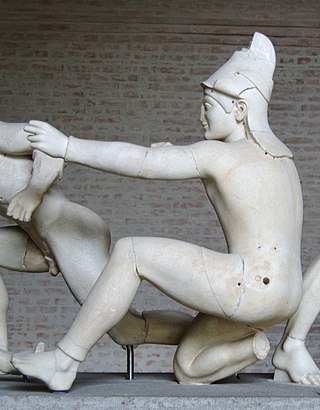
Marble has been the preferred material for stone monumental sculpture since ancient times, with several advantages over its more common geological "parent" limestone, in particular the ability to absorb light a small distance into the surface before refracting it in subsurface scattering. This gives an attractive soft appearance that is especially good for representing human skin, which can also be polished.

Sir Jacob Epstein was an American-British sculptor who helped pioneer modern sculpture. He was born in the United States, and moved to Europe in 1902, becoming a British subject in 1910.
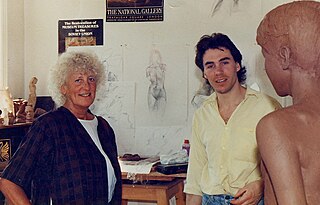
Dame Elisabeth Jean Frink was an English sculptor and printmaker. Her Times obituary noted the three essential themes in her work as "the nature of Man; the 'horseness' of horses; and the divine in human form".

Frederick Elliott Hart was an American sculptor. The creator of hundreds of public monuments, private commissions, portraits, and other works of art, Hart is most famous for Ex Nihilo, a part of his Creation Sculptures at Washington National Cathedral, and The Three Servicemen, at the Vietnam Veterans Memorial in Washington, D.C.
Gerald Gladstone was a Canadian sculptor and painter.
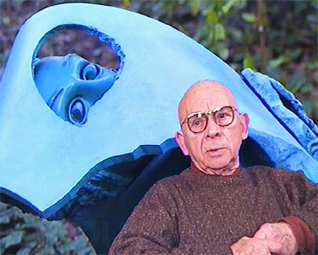
Jean-Robert Ipoustéguy, a figurative French sculptor, was born "Jean Robert" in Dun-sur-Meuse. His artwork had a distinct style, combining abstract elements with the human figure, often in the écorché style of French anatomists. The American writer John Updike once wrote that he "may be France's foremost living sculptor, but he is little known in the United States". He and other critics noted sharp contrasts between rough and smooth, abstract and realistic, tender and violent, delicate and crude, and many other paired oppositions in his artwork, and his recurrent themes of sex, birth, growth, decay, death, and resurrection. Ipoustéguy was unafraid to depict emotional intensity in a sometimes controversial way; several of his major commissioned works were rejected, but later installed as planned, or in other locations.

"Anne Chu was born in 1959 in New York City. Her parents came from China, and her father was a mathematics professor at Columbia University. When she was in middle school, her family moved to Westchester County, north of the city. She graduated from the Philadelphia College of Art in 1982 and received an MFA from Columbia University in 1985".

Stephen De Staebler was an American sculptor, printmaker, and educator, he was best recognized for his work in clay and bronze. Totemic and fragmented in form, De Staebler's figurative sculptures call forth the many contingencies of the human condition, such as resiliency and fragility, growth and decay, earthly boundedness and the possibility for spiritual transcendence. An important figure in the California Clay Movement, he is credited with "sustaining the figurative tradition in post-World War II decades when the relevance and even possibility of embracing the human figure seemed problematic at best."
Mark Prent was a Canadian sculptor and performance artist that lived in the United States and was best known for the graphic realism of his figurative sculpture. Prent's sculptures have been described as disturbing and even brutal. His work was the subject of a 1972 lawsuit in which a gallery, exhibiting one of his works consisting of a butcher’s counter of human body parts, was charged with "exhibiting a disgusting object". Prent was the subject of the 1976 documentary "If Brains Were Dynamite [You Wouldn't Have Enough to Blow Your Nose] - Mark Prent".
Martin Eichinger is an American sculptor. Deemed one of the few 'Living Masters' by the Art Renewal Center, Eichinger is known for his bronze narrative sculptures that, as he puts it, "chronicle the eternal human pursuit of meaning, happiness, and growth." Eichinger has been sculpting for over 40 years and is represented by many elite galleries across the country. He currently lives in Portland, Oregon and is an active and influential figure in the Northwestern sculpting community.
Gary Freeman (1937–2014), is an American sculptor from Indianapolis, Indiana. He is Professor Emeritus of Indiana University-Purdue University Indianapolis (IUPUI) and served as head of the Herron School of Art Sculpture Department for 33 years, from 1968 until his retirement in 2001.
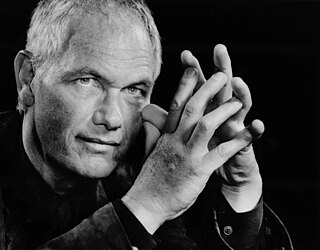
Richard MacDonald is a California-based contemporary figurative artist known for his bronze sculptures and his association with Cirque Du Soleil.
Una Mavis Ehlert was a British-Canadian sculptor.
Sam Jinks is an Australian sculptor who creates lifelike but fragile figures using silicone, resin, calcium carbonate, fibreglass and hair. Jinks describes the human form as "a physics lesson in a ball of bones and meat". Jink's work has been exhibited in Australia and internationally.

Jim Rennert is an American figural sculptor, working primarily in bronze depictions of everyman figures in business suits. He grew up in the Southwest United States before moving to Dallas, where he became a businessman. After 10 years in the business world, Rennert took up sculpting, initially of children and sports figures. In 2004, he began his Everyman series of men in business suits for which he is best known. The Everyman series depicts figures in suits and deals with everyday challenges and struggles meant to be immediately relatable to any given viewer. He has had several public exhibitions of large-scale works, including in New York's Union Square and on Sixth Avenue, as well as the Ann Norton Sculpture Garden in Palm Beach.
Ethel Rosenfield was a Polish-born Canadian sculptor who lived in Montreal, Quebec. After enrolling in art classes in her mid-forties, she began working primarily in limestone and marble, exploring "organic forms, abstract or schematized, the latter representing faces and female bodies". Rosenfield co-founded the Quebec Sculptors' Association in 1962, and her work was exhibited at the Rodin Museum, Expo 67, the Montreal Museum of Fine Arts, and multiple Canadian universities. Her sculptures are held in permanent collections at Concordia University, the Musée d'art contemporain de Montréal, and the Storm-King Art Centre.
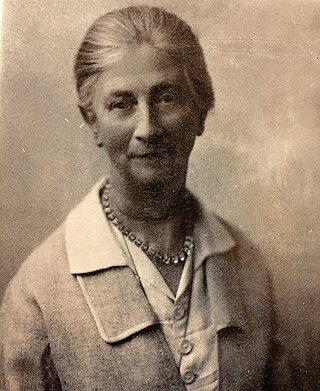
Katherine Elizabeth Wallis (1861–1957) was a Canadian sculptor, a watercolor painter and poet. She traveled all over the world, observing art, studying sculpture and advancing her artistic career. Wallis is best known for bronze sculptures of animals and infants.

Gudmar Olovson was a Swedish sculptor, artist, engraver and lithographer.
Romolo Del Deo is an American sculptor, artist, and teacher. Best known for his bronze sculptures that put a “contemporary spin on the classical,” Del Deo’s art primarily explores two aesthetic themes: the debris that washes up on the shores of his native Provincetown, MA, and the archeological ruins of Italy. Del Deo is founder of the “Long Art”


















